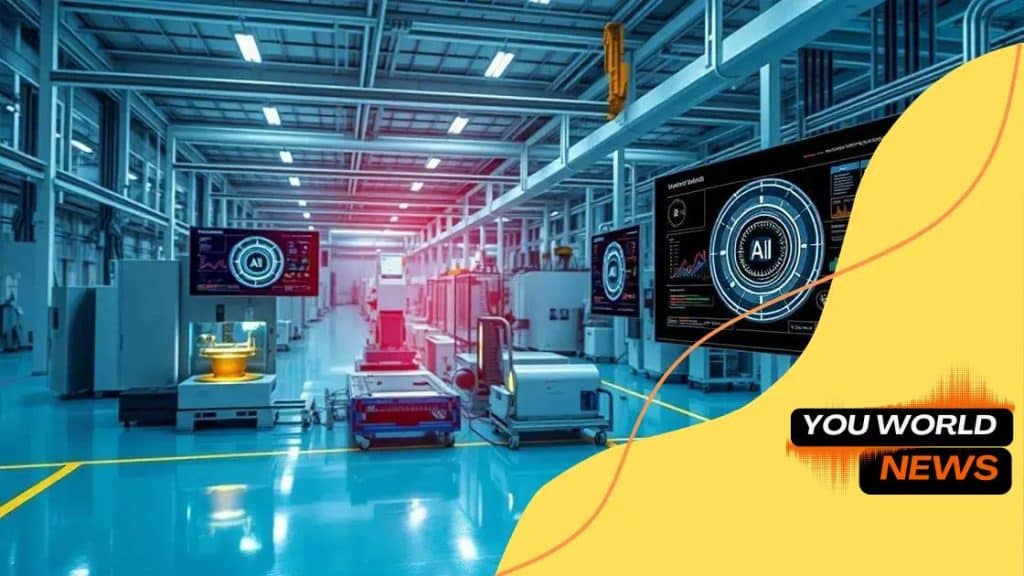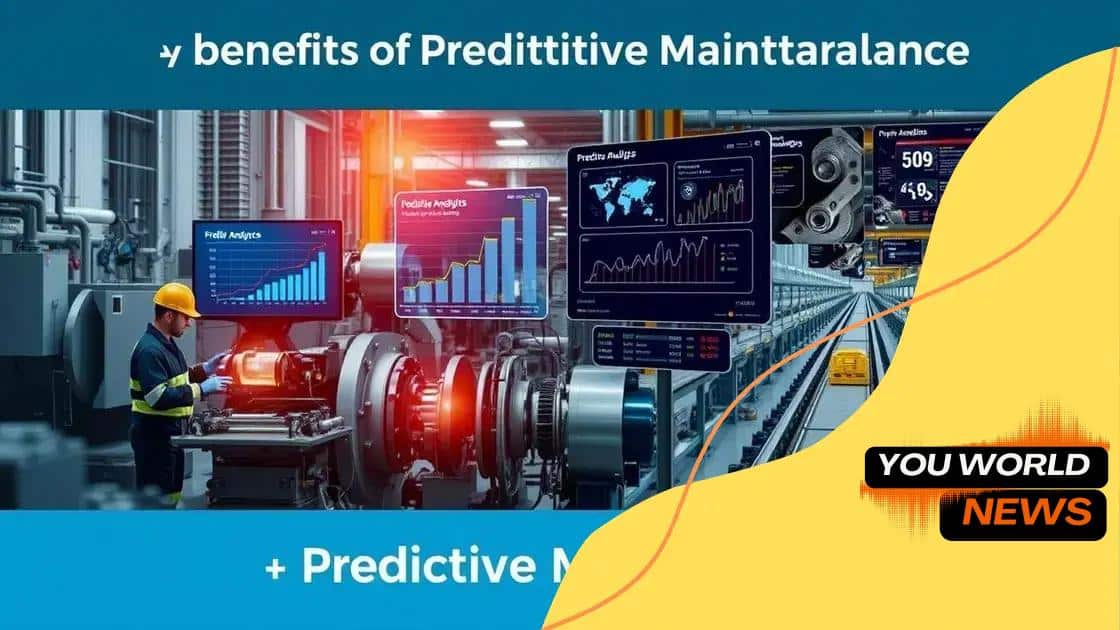AI in predictive maintenance for manufacturing is transforming industries

AI in predictive maintenance for manufacturing enhances efficiency and reduces downtime by utilizing data analytics to predict equipment failures, ultimately improving operational performance and reducing costs.
AI in predictive maintenance for manufacturing is reshaping how industries approach equipment management. Imagine reducing costly downtimes and ensuring smooth operations—sounds intriguing, right? In this article, we’ll explore how AI can optimize your maintenance strategies.
Understanding predictive maintenance
Understanding predictive maintenance is crucial for companies aiming to improve their operations. This approach allows businesses to anticipate equipment failures before they occur. By leveraging data and technology, organizations can optimize their maintenance schedules and reduce unexpected downtimes.
The basics of predictive maintenance
Predictive maintenance involves using real-time data and analytics to forecast when maintenance should be performed. This method contrasts with traditional maintenance strategies that may rely on fixed schedules or react to equipment failures.
- Data Analysis: Collecting and analyzing data from machinery helps identify patterns and anomalies.
- Machine Learning: Algorithms can learn from historical maintenance data to predict future failures.
- Cost Savings: Reducing unplanned downtimes translates to significant financial savings for manufacturers.
Next, it’s vital to understand how predictive maintenance contributes to a culture of proactive management. When companies prioritize predicting issues, they foster an environment that values efficiency and reliability.
Benefits of predictive maintenance
The advantages of implementing predictive maintenance are substantial. Organizations not only save money but also enhance the overall lifespan of their equipment. By shifting from reactive to proactive strategies, teams can work more efficiently.
Moreover, predictive maintenance supports innovation. When companies invest in advanced technologies, they lead the way in their industry. Integrating sensors and IoT devices enhances data collection, making predictions more accurate.
Ultimately, understanding predictive maintenance sets the stage for manufacturers to thrive in an increasingly competitive environment. This approach represents a shift towards smarter, data-driven decisions that can significantly benefit the entire organization, paving the way for future advancements.
The role of AI in manufacturing
The role of AI in manufacturing is becoming increasingly vital as industries strategize for the future. By integrating artificial intelligence, companies can enhance efficiency, reduce waste, and improve product quality.
Enhancing decision-making
AI plays a significant role in supporting decision-making processes. Through data analysis, AI systems can predict trends and identify areas for improvement. This capability allows manufacturers to make informed decisions that positively impact their bottom line.
- Data-Driven Insights: AI analyzes vast amounts of data quickly, providing actionable insights.
- Real-time Monitoring: AI enables continuous tracking of production processes, ensuring optimal performance.
- Resource Optimization: By analyzing operational data, AI can recommend best practices to reduce costs.
Additionally, the integration of AI in manufacturing lines allows for the automation of routine tasks. This shift not only boosts productivity but also frees human workers to focus on more complex challenges. In turn, this boosts job satisfaction and employee engagement.
Predictive analytics benefits
Another critical aspect is predictive analytics, which enables manufacturers to foresee equipment failures and maintenance needs. By utilizing AI algorithms, businesses can analyze historical data to identify patterns and predict future malfunctions.
Such predictive capabilities can lead to enhanced organizational efficiency and reduced downtime. Consequently, companies that embrace AI are more likely to stay ahead of competitors and adapt to changing market demands quickly. In essence, AI is no longer a luxury but a necessity for manufacturers looking to thrive in an evolving landscape.
Key benefits of predictive maintenance

Key benefits of predictive maintenance have made it an essential strategy for manufacturers. By implementing this approach, companies can significantly enhance operational effectiveness and reduce costs.
Increased Equipment Longevity
One major advantage of predictive maintenance is the extended lifespan of equipment. By regularly monitoring machinery and addressing issues before they escalate, businesses can avoid costly breakdowns that lead to expensive repairs and replacements. This proactive approach ensures machines operate optimally for longer periods.
- Cost Efficiency: Preventative measures save money by reducing emergency repairs.
- Improved Production: Machinery can run more smoothly without unexpected interruptions.
- Better Resource Management: Maintenance teams can plan their work more effectively.
Moreover, companies that utilize predictive maintenance often see improved safety levels in the workplace. By minimizing equipment failures, there are fewer accidents that could potentially harm employees. This focus on safety fosters a positive work environment, leading to higher employee morale.
Enhanced Productivity and Efficiency
Another significant benefit is the boost in productivity and efficiency. With less downtime, production schedules remain steady, allowing businesses to meet deadlines and customer demands consistently. Predictive maintenance helps orchestrate a seamless workflow within manufacturing processes.
Additionally, this strategy facilitates informed decision-making. Data collected from predictive maintenance tools enables companies to analyze trends and make adjustments accordingly. Such adaptations can enhance overall production quality while minimizing waste.
In the end, the key benefits of predictive maintenance illustrate its value in modern manufacturing. Investing in this approach translates to more robust operations, improved safety, and ultimately, a stronger competitive edge in the market.
Real-world applications of AI
Real-world applications of AI in manufacturing showcase how technology can transform processes and drive innovation. Industries are leveraging AI to solve complex challenges, enhance efficiency, and ultimately deliver better products.
Predictive Analytics in Action
One prominent application is in predictive analytics. Here, AI systems analyze historical data from machines to anticipate failures before they happen. By identifying patterns and anomalies, manufacturers can schedule maintenance proactively, reducing downtime and preventing costly repairs.
- Case Study: A major automotive company used AI to predict equipment failures, leading to a 20% reduction in maintenance costs.
- Sensor Integration: Smart sensors collect data in real-time, feeding AI algorithms for analysis.
- Impact: Enhanced equipment reliability and improved production schedules.
Additionally, AI is revolutionizing quality control. Through image recognition and machine learning, AI systems can inspect products at incredible speeds, identifying defects that human inspectors might miss. This ensures that only high-quality products reach customers.
Supply Chain Optimization
Another vital application of AI lies in supply chain optimization. AI algorithms assess various factors such as supplier reliability, market demand, and logistics. By balancing these elements, manufacturers can streamline their supply chains and reduce costs.
Moreover, AI-powered robots are becoming common in production lines. These robots perform repetitive tasks quickly and accurately, allowing human workers to focus on more strategic roles. This collaboration enhances productivity and efficiency throughout the manufacturing process.
In summary, the real-world applications of AI in manufacturing demonstrate the technology’s capacity to redefine industry standards. From predictive maintenance to quality control, AI is at the forefront of the evolution in manufacturing, leading companies towards a more efficient and innovative future.
Challenges in implementing AI solutions
Challenges in implementing AI solutions are often significant roadblocks for many companies. Although AI offers numerous benefits, integrating this technology into existing systems requires careful planning and consideration.
Data Quality and Availability
One major challenge is ensuring data quality and availability. AI systems depend on large amounts of accurate and well-structured data. If the data quality is poor or inconsistent, it can significantly impact the performance of AI tools.
- Inconsistent Data: Discrepancies in data formats can hinder analysis.
- Data Collection: Gathering sufficient data from various sources can be complex.
- Data Security: Protecting sensitive information adds another layer of difficulty.
Furthermore, companies must also consider the costs associated with implementing AI solutions. This can include expenses related to software, hardware, and training personnel. Many organizations struggle to justify these costs, especially when results may take time to materialize.
Workforce Adaptation
Another significant hurdle is workforce adaptation. Employees may feel threatened by the introduction of AI technologies, fearing job displacement. This mindset can create resistance to adopting new systems. Ensuring that staff members understand how AI will augment rather than replace their roles is crucial.
Training is essential for successful implementation. Organizations should invest in upskilling their workforce to work alongside AI systems comfortably. By fostering a culture of continuous learning, companies can create a more accepting environment where employees feel supported in adapting to the transformations AI brings.
Finally, navigating regulatory and ethical concerns is crucial when implementing AI. Companies must comply with various laws and regulations, which can be complex and vary by location. Ensuring that AI practices are ethical and responsible must remain a priority. By tackling these challenges head-on, organizations can harness the full potential of AI technology.
FAQ – Frequently Asked Questions about AI in Manufacturing
What is predictive maintenance?
Predictive maintenance uses data analysis to predict when equipment failures might occur, allowing companies to prevent issues before they happen.
How can AI improve quality control?
AI can improve quality control by using image recognition to quickly identify defects in products that human inspectors might miss.
What are the main challenges of implementing AI?
The main challenges include ensuring data quality, managing costs, and helping the workforce adapt to new technologies.
What benefits can manufacturers expect from AI?
Manufacturers can expect benefits such as increased efficiency, reduced costs, improved product quality, and enhanced safety in the workplace.





